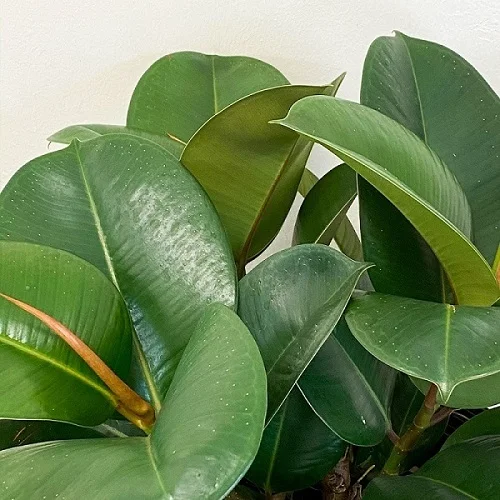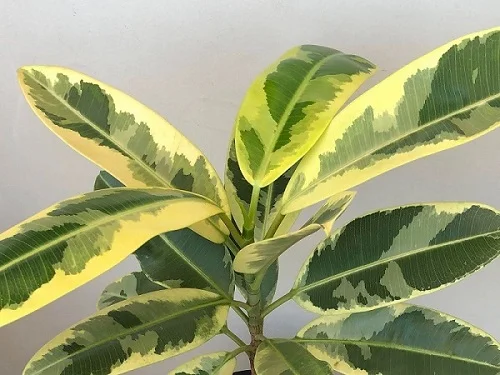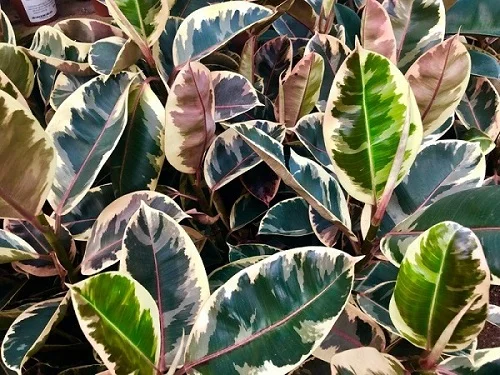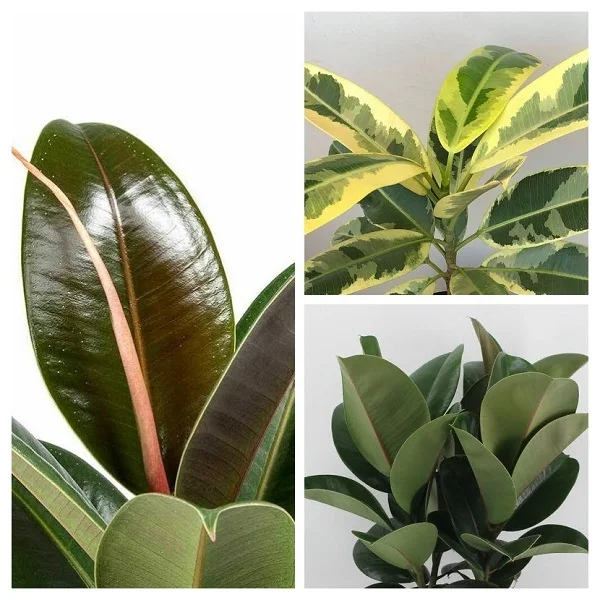14 Reasons for Rubber Plant Leaves Falling Off and their Remedies
Some links in this post may be affiliate links
Rubber Plant dropping leaves is due to rot-rot, pests infestations, insufficient light, salts buildup, nutrients deficiency, inconsistent watering, soggy soil, temperature stress among others.
Rubber Plant botanically called, Ficus elastica, is the easiest of the Ficus varieties for indoor and outdoor growing as it easily adapts to a wide range of growing conditions.
Ficus elastica grows best in bright light with 4-6 hours of sunshine, warmth of 15-280C, humidity of 50-55% and moderately moist, fertile, well-drained soil coupled with monthly feeding in spring and summer. Learn how to grow and care for Rubber Plants.
If you fail to provide the right growing conditions for your Rubber Plant it may drop it leaves. We have herebelow discussed 14 reasons why a Ficus elastica may shed leaves and how to fix it.

14 Causes of Rubber Plant Dropping Leaves & Solutions
1. Root-rot Disease
Rubber Plant is prone to root-rot which is prevalent in soggy soil and is characterized by wilted, discolored leaves, corky swellings under the leaves and leaf loss.
Soggy soil reduces oxygen concentration in the soil which causes the roots to die. Once the roots die, they cannot take up water and nutrients to the leaves. The leaves begin to wilt and eventually drop.
Solutions
Carefully slip your Rubber Plant out of its pot and inspect the roots; brown-black mushy roots indicate root-rot, trim them off.
Treat the healthy roots with a fungicidal solution as instructed by the manufacturer.
Disinfect the pot with the fungicidal solution or use a fresh pot to repot the plant in fresh free-draining soil.
Do not water the plant immediately; keep it dry for a few days before resuming watering.
2. Poor Quality Soil
Poor quality soil does not drain easily and therefore it easily becomes compacted or soggy which can negatively impact the growth of your Rubber Plant.
Rubber Plant requires loose, free-draining soil that does not hold excessive amounts of water as soggy soil can lead to root-rot which is characterized by yellowing and shedding leaves.
Solutions
Pot your Rubber Plant in good quality soil that is loose, free-draining and rich in organic matter. Most all purpose potting mixes are ideal for this plant.
3. Pest Infestations
Rubber Plant is prone to aphids, mealybugs, scale insects and spider mites which are more common in weak plants and in extremely dry conditions.
These pests attack the new growth from where they suck the plant sap which causes the plant to become dehydrated resulting in wilting and loss of leaves.
Solutions
Regularly inspect your Rubber Plant between and underneath the leaves for the pests and take timely control measures.
Treat the infested plant with neem oil or insecticidal soap as per the manufacturer's instructions.
Maintain the plant properly pruned to get rid of their breeding ground to discourage infestations by these pests.
Ensure that your plants are healthy at all times by providing the right growing conditions.
Increase humidity by setting the pot on a wet pebble tray, use of a humidifier or grouping the plant together to discourage these pests.

4. Insufficient Light
Adequate light is needed for making food that is required for energy and growth. Insufficient light implies that the plant cannot make enough food for energy and growth.
In an attempt to save energy, the plant begins to drop leaves. This way, it saves the available energy for the vital functions to keep alive.
Solutions
Cutback the bare stems to promote new growth and also encourage a bushy, compact growth.
Position your Rubber Plant in a brighter spot where it will receive bright light with 4-6 hours of sunshine. A spot infront of a large, well-lit window which receives some morning or late afternoon sunshine is ideal for the plant.
You may instal a grow light if you do not have enough natural light in your home.
Regularly rotate the pot to ensure that the plant absorbs enough light on all sides.
Ocassionally clean the leaves by damp wiping with a soft cloth to increase surface area for light absorption.
5. Salts Buildup
Accumulation of salts in the soil will cause the roots to die due to fertilizer burn. This means that the roots cannot take up nutrients and water required for photosynthesis. Without adequate food for growth and energy, the plant begins to lose leaves to save energy for the vital functions.
Solutions
Do not feed your Rubber Plant in fall and winter as growth is minimal at this time and feeding at this time can lead to salts buildup.
Use chemical free water like rain water or filtered water to prevent buildup of salts in the soil.
Flush out the accumulated salts regularly by running a stream of water through the soil until it comes out through the drainage holes. Repeat the process several times to clear as much salt as possible.
6. Nutrients Deficiency
Underfeeding implies that the plant is not getting enough nutrients need for growth and energy. Lack of nutrients in the actively growing tips causes nutrients to be withdrawn from the older lower leaves which begin to yellow and fall off.
Solutions
Feed your Rubber Plant with a balanced, water-soluble fertilizer in spring and summer. Ensure to follow the instructions on the label of the plant food.

7. Being Pot-bound
If the plant is pot-bound, the roots have filled the pot and there is very little soil to hold water when you water the plant. Therefore, there is no water for the plant to take up to the leaves. The leaves loss their stiffness, begin to wilt and drop.
Solutions
Check the bottom of the pot for roots growing through the drainage hole and repot your Rubber Plant into a pot one size larger than the current one.
Ascertain that the pot has a drainage hole and that the soil is loose and well-drained. Use a heavy pot as the plant can become top-heavy and topple over. Take a look at these ceramic pots with a drainage hole on Amazon.
8. Repotting Shock
Repotting may cause the plant some shock. This may lead to some leaves wilting and dropping before the plant can adjust to the new growing conditions.
Solutions
To minimize repotting shock, water the Rubber Plant thoroughly one day before repotting; a well hydrated plant experiences less shock and establishes much faster.
Do not make too many changes at once. For instance, after repotting, maintain the plant in the same location until it is well established before moving it to a new location.
9. Soggy Soil
Soggy soil (excess water in the soil) reduces the oxygen concentration in the rootzone and this causes the roots to die. Therefore, they cannot take up water and nutrients needed for the making food. Lack of enough food causes the plant to shed its leaves.
Solutions
Pot your Rubber Plant in a pot one size larger with a drainage hole and well-draining soil.
Cut down on watering in fall and winter to maintain the soil slightly moist as growth is minimal at this time.
10. Inconsistent Watering
Both underwatering and overwatering negatively affect the growth of the plant. Underwatering causes wilting, drooping, yellowing, leaf drop and eventual death of the plant.
On the other hand, overwatering results in soggy soil which causes rotting, yellowing, leaf fall and plant death if the situation is not corrected.
Solutions
Immediately water the plant thoroughly until water comes out through the drainage holes and it should recover.
Thereafter, water the Rubber Fig liberally in spring and summer and allow the top 2-3 inches of soil to dry out between waterings.
Decrease watering in fall and winter but do not allow the soil to dry out completely; maintain the soil slightly moist.

11. Temperature Stress
Extreme temperatures; either too high or too low due to exposure of the plant to drafts will affect the normal functioning of the plant systems.
Too high temperatures will cause excessive loss of water leading to wilting and leaf drop while too low temperatures result in reduced growth and leaf loss.
Solutions
Keep your Rubber Plant away from sources of drafts like drafty winds, AC vents, open doors, hot surfaces, hot air vents and others.
Maintain an average warmth of 15-280C for optimal growth of the plant; a room temperature that is comfortable for you is ideal for the plant.
12. Too Cold Water
Rubber Plant is a tropical plant where it grows in consistently warm temperatures through out the year. Therefore, watering this plant with too cold water will shock the plant causing to shed its leaves.
Solutions
Water your Rubber Plant with water that is at room temperature to avoid cold shock and eventual death of the plant.
13. Sudden Changes in Growing Conditions
Rubber Plant is sensitive to sudden changes in growing conditions and it responds with leaf drop. This is likely to occur when you bring the plant home or when you move it to a new location in the home.
Solutions
When you bring your Rubber Plant home, place it in a warm place in bright light with 4-6 hours of morning or late afternoon sunshine.
Water the plant when the top 2-3 inches of soil dry out between waterings. It may loss a few leaves but will eventually settle.
If you need to move the plant to a new location in the home, do so gradually to acclimate it to the new conditions. For instance, if you want to take it outside, move it to a shaded place first before you can take out under bright light.
14. Aging
As the matures, it loses the lower leaves leaving a bare stem with a crown of leaves at the top. Loss of lower leaves is a normal occurence in this plant.
Solutions
Cutback your Rubber Plant stem at the desired height to rejuvenate growth. New growth should sprout just below the cut into a new bushy plant.
You liked it? Share on social media.
Related Content
Amazon Associates Disclosure
Homeplantsguide.com is a participant in the Amazon Services LLC Associates Program, an affiliate advertising program designed to provide a means for sites to earn advertising fees by advertising and linking to amazon.com.





